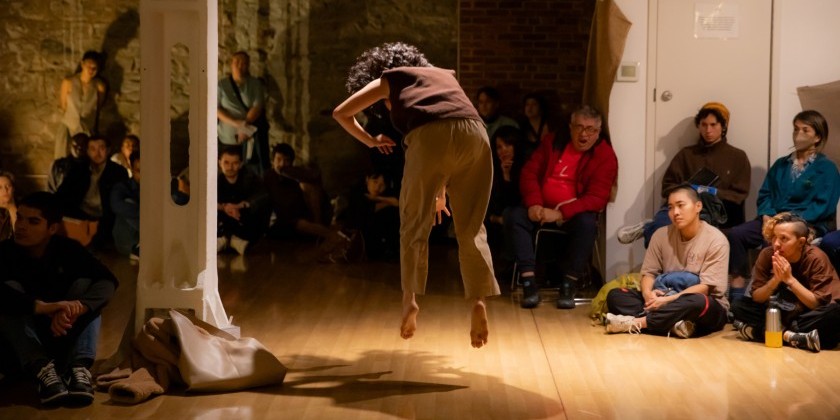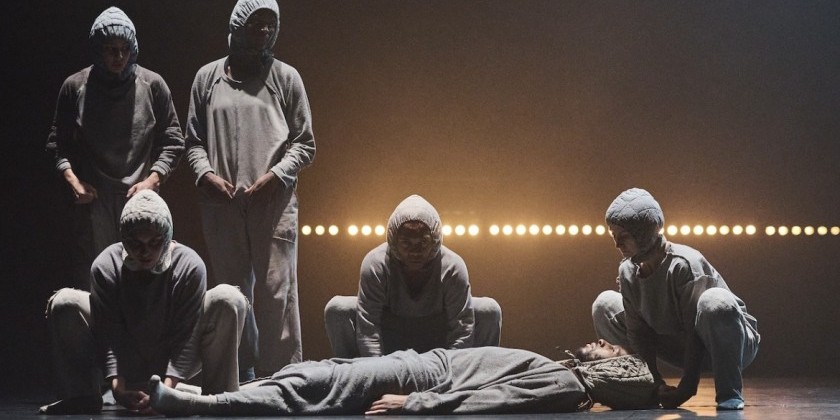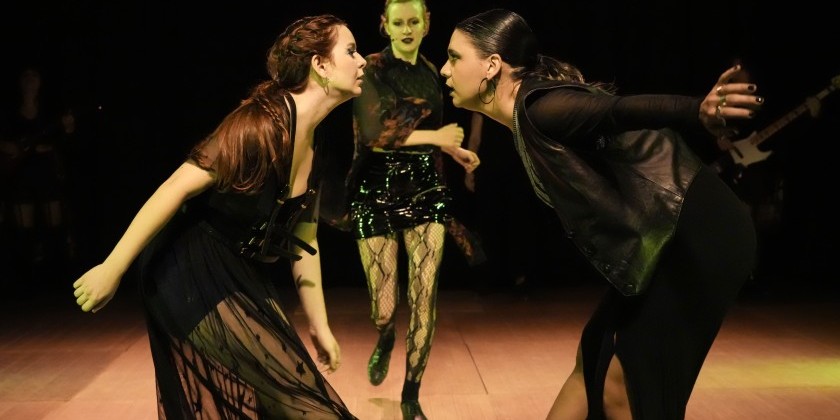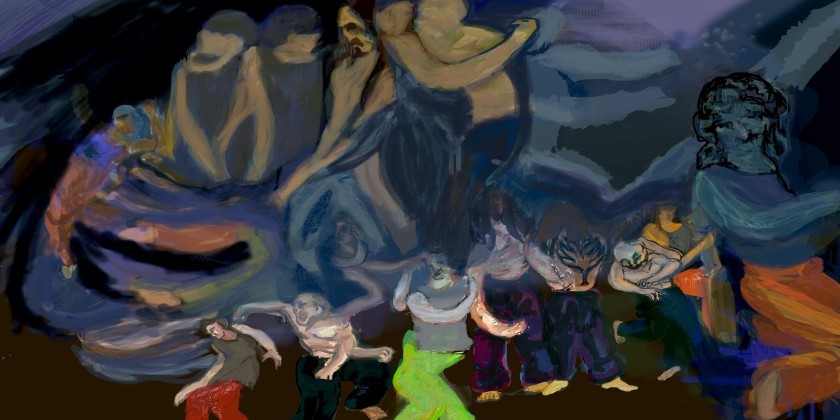AUDIENCE REVIEW: "We Are Particles" by Katelyn Halpern & Dancers

Company:
Katelyn Halpern and Dancers
Performance Date:
04/25/2019
Freeform Review:
We Are Particles: A Contemporary Dance Mixed Bill Review
Charly Santagado – 4/26/19
The cozy setting of SMUSH Gallery never ceases to provide warmth, intrigue, and a healthy dose of vulnerability to its audience. Last night’s event curated by Ross Daniel and directed by SMUSH Gallery Owner Katelyn Halpern surpassed all expectations and, in spite of the numerous high-caliber events I have attended at the small venue, was the most sophisticated and interesting show I’ve had the fortune to attend in that space (and quite frankly outshone many shows I’ve seen at fancier or more “official” venues.)
Program A featured the solo work of Madelyn Sher called “Us, American”, a duet work-in-progress by Katelyn Halpern which shared the show’s title “We Are Particles”, and another duet “Burrow, tousel” improvised by Amanda Marais and Kara Brody. Each piece was a unique blend of experimental and thoughtful movement and made excellent use of the limited movement space available.
Us, American
The first piece of the evening, Sher’s “Us, American” explored a number of provocative themes. Madelyn entered the space in a black out and the lights came up to her slowly dripping down into the floor. She wasn’t wearing makeup and had an “I heart NY” T-shirt on with casual workout shorts. The first part of her piece was a contrast between very slow movement and quick, powerful responses that left me wishing for more movement and less stillness. Her sound score switched between rap and instrumental music, again calling attention to opposites.
The most memorable part of her piece was definitely the last section when she used extremely clear-cut and sharp arm movements to build a city skyline in the air around the space. At first she constructed her city slowly and with care and precision, but as she progressed her movements became more chaotic and embodied, reflecting the growth of NYC, her home “town”, and of America as a whole. Throughout the piece, Madelyn introduced a significant number of provoking ideas and displayed a stimulating movement vocabulary, but I wanted to see nearly all of her ideas developed further. The title of her work is reminiscent of Stephen Colbert’s satirical book “I Am America (And So Can You!)”, further emphasizing the irony behind her movement.
We Are Particles
The second piece of the night was Halpern’s duet “We Are Particles” featuring herself and Ross Daniel as dancers. Despite its description as a work in progress (and even without having had this information), the piece was the most cohesive of the night and if I had to give just one takeaway, it would be this: Straight people can be queer too. Part 1 of the piece was titled “exposure” and it started with a monologue delivered in a slight southern accent by Ross and a solo performed by Katelyn with the most prominent movement motif being her holding one armpit with the opposite hand. This motif appeared throughout the entire piece. The monologue contemplated the existence of tiny particles – the kind you only see when light is streaming through the window – and how we touch and collide with such particles every moment of every day without realizing it. This spoken image was actualized through the use of a flashlight coming from the downstage left corner flicking on and off at various times, illuminating the dancers and casting their shadows on the white wall behind them. One particularly haunting instance of these shadows was when Ross lifted Katelyn in a superman position and spun her slowly from stage left to stage right, her shadow dancing on the wall in a mesmerizing spiral.
Part 2 was called “landforms” and in it the focus shifted from being primarily on Katelyn to the relationship between the two dancers. There was a great deal of weight sharing and the content – a series of unique, intertwined positions – clearly represented a romantic relationship while successfully avoiding clichés, often a difficult task when telling a love story. One particularly rousing image was Katelyn standing on Ross’s hips while he was lying on his back. After a powerful opening, this slower section felt earned and played a major role in the development of the piece.
The final section was called “pleasure” and it started out as a straightforward representation of just that. The couple emerged in long pink skirts and began dancing to upbeat music, flirting with each other and the audience sometimes subtly and sometimes hyperbolically. The music and the dancers eventually slowed and became more romantic, drawing on many themes and movements that had initially been introduced at the beginning of the piece. This entire section rounded out a few ideas that had been brewing since the beginning of the piece. 1) That the audience was getting a secret glimpse of the inner workings of a quirky, highly emotional, absolutely beautiful relationship (like looking through a peep hole). 2) That the dancers represented two molecules that happened to bump into each other one day, small and only rarely illuminated by some flashlight or through some window, but always present. And (as mentioned earlier) 3) That molecules and love don’t give a damn about gender norms and are happy to flounce around in all pink as long as they’re free to flounce. This display of a straight couple as nebulously queer along with the beautiful love story that developed throughout the course of the piece made it heart-warming, highly relatable, and Halpern’s strongest work yet.
Burrow, tousel
The final piece of the night was a duet performed by Maraist and Brody to an original musical work by Chrissy Martin. The soundscape was sparse, containing only one voice that alternated between guttural and meditative tones. The set contained a few cozy lamps and two industrial lights as well as around 15 pillows that the dancers used as props throughout the piece. This set gave off a bedroom atmosphere, which contributed to the undertone of romance that pervaded the piece. I learned only afterward that the duet was improvised, an impressive feat in itself rendered more impressive by the SMUSHed space and complicated, continuously evolving pillow formations.
The dancers each had their own distinct style, both equally mesmerizing. Maraist’s movement had a quirky, light feel while Brody was smooth, grounded, and controlled. Their contrasting styles made their partner-work all the more compelling and their weight-sharing was the highlight of the piece; the dancers’ complete trust in each other was evident and gave valuable insight about their relationship. The dancers also maintained a very casual air that felt almost non-performative. This lead to the feeling that they were merely working in the studio and was complimented by regular laughter and quiet words here and there. (I find that such communication often feels forced in dance-based works, but other than in a few small instances, the audible interactions seemed to work for this piece and felt genuine.) While hints of eroticism did peep through, the part of the relationship emphasized was artistic partnership. It seemed clear that they were crafting something together.
These apparent roles as artists crafting their work in real time reared its head as meta-commentary on improvised performance in general. (Improvising about improvising, creating about creating, and so on.) The best evidence of this underlying idea was the constant rearranging of the pillows and lighting along with the occasional stepping away of one dancer to look in on the image that had just been created. The most memorable instance of this came about two-thirds of the way through the piece with Brody lying on her stomach on the floor. Maraist surrounded her body with pillows patiently and strategically and when she was satisfied with the formation, moved the industrial lights so that they were pointing at Brody’s pillow-framed body and eventually at her face directly. Another similar moment came when the two dancers built a pillow pyramid. When Brody wasn’t sure where to put the last pillow, Maraist gestured where to put it and they both sat back against the pillows, admiring their work in the lamplight. While I greatly enjoyed the piece and respect its aims, it did drag a bit toward the end and could be shortened. In addition, the final section felt anticlimactic after some of the more striking images in the piece and a more logical, powerful ending would have been the moment when each dancer was sitting on two pillows on either side of the scene that they had just jointly composed, which was the first major instance of symmetry and unison in the entire work.
Author:
Charly Santagado











